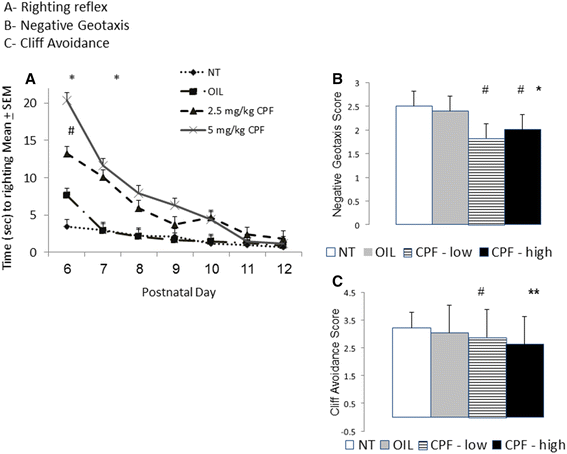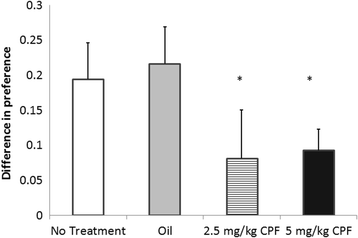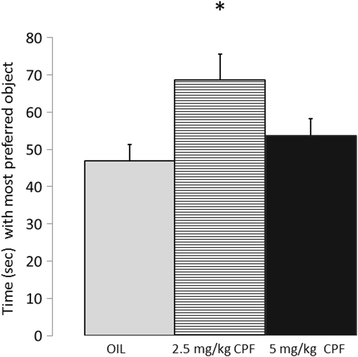Prenatal chlorpyrifos leads to autism-like deficits in C57Bl6/J mice
- PMID: 28464876
- PMCID: PMC5414283
- DOI: 10.1186/s12940-017-0251-3
Prenatal chlorpyrifos leads to autism-like deficits in C57Bl6/J mice
Abstract
Background: Children are at daily risk for exposure to organophosphate insecticides, of which the most common is chlorpyrifos (CPF). Exposure of pregnant women to CPF was linked to decreased birth weight, abnormal reflexes, reduction in IQ, as well as increased maternal reports of signs of pervasive developmental disorder. The aim of current study was to examine the long term effects of prenatal exposure to CPF in C57BL/6 J (B6) mice with specific focus on social and repetitive behavior.
Methods: B6 female mice were treated with vehicle, 2.5 mg/kg CPF or 5 mg/kg of CPF on gestational days 12-15 by oral gavage. On postnatal days (PND's) 6-12 early development and neuromotor ability were assessed by measuring 3 neonatal reflexes in the offspring. In adulthood, PND 90, social behavior was investigated using the social preference, social novelty and social conditioned place preference tasks. Object recognition and restricted interest, measured by the repetitive novel object contact task (RNOC), were also assessed on PN D 90. In order to rule out the possibility that CPF administration induced alterations in maternal care, the dams' behavior was evaluated via the maternal retrieval task.
Results: CPF treatment resulted in delayed development of neonatal reflexes on PND's 6-12. On PND 90, mice treated prenatally with the 5.0 mg/kg dose exhibited reduced preference towards an unfamiliar conspecific in the social preference test and reduced social conditioned place preference. In the RNOC task, mice exposed prenatally to 2.5 mg/kg dose of CPF showed enhanced restricted interest. CPF administration did not impair dams' behavior and did not cause memory or recognition deficit as was observed in the object recognition task.
Conclusions: Our data indicate that gestational exposure to CPF has long-term deleterious effects on social behavior and limits exploration of novel objects.
Keywords: Autism; Chlorpyrifos; Pesticide; Prenatal; Restricted interest; Social deficit.
Figures




Similar articles
-
Impaired innate and conditioned social behavior in adult C57Bl6/J mice prenatally exposed to chlorpyrifos.Behav Brain Funct. 2019 Mar 1;15(1):2. doi: 10.1186/s12993-019-0153-3. Behav Brain Funct. 2019. PMID: 30823929 Free PMC article.
-
Prenatal exposure to the organophosphate insecticide chlorpyrifos enhances brain oxidative stress and prostaglandin E2 synthesis in a mouse model of idiopathic autism.J Neuroinflammation. 2016 Jun 14;13(1):149. doi: 10.1186/s12974-016-0617-4. J Neuroinflammation. 2016. PMID: 27301868 Free PMC article.
-
Gestational/perinatal chlorpyrifos exposure is not associated with autistic-like behaviors in rodents.Crit Rev Toxicol. 2014 Jul;44(6):523-34. doi: 10.3109/10408444.2014.907772. Epub 2014 May 27. Crit Rev Toxicol. 2014. PMID: 24861450 Review.
-
Sex-dimorphic effects of gestational exposure to the organophosphate insecticide chlorpyrifos on social investigation in mice.Neurotoxicol Teratol. 2014 Nov-Dec;46:32-9. doi: 10.1016/j.ntt.2014.09.002. Epub 2014 Sep 28. Neurotoxicol Teratol. 2014. PMID: 25261807
-
Evaluation of epidemiology and animal data for risk assessment: chlorpyrifos developmental neurobehavioral outcomes.J Toxicol Environ Health B Crit Rev. 2012;15(2):109-84. doi: 10.1080/10937404.2012.645142. J Toxicol Environ Health B Crit Rev. 2012. PMID: 22401178 Free PMC article. Review.
Cited by
-
Early-life exposure to endocrine-disrupting chemicals and autistic traits in childhood and adolescence: a systematic review of epidemiological studies.Front Endocrinol (Lausanne). 2023 Jun 9;14:1184546. doi: 10.3389/fendo.2023.1184546. eCollection 2023. Front Endocrinol (Lausanne). 2023. PMID: 37361542 Free PMC article.
-
Exposure to Environmental Pesticides and the Risk of Autism Spectrum Disorders: A Population-Based Case-Control Study.Medicina (Kaunas). 2024 Mar 14;60(3):479. doi: 10.3390/medicina60030479. Medicina (Kaunas). 2024. PMID: 38541205 Free PMC article.
-
Altered Developmental Trajectory in Male and Female Rats in a Prenatal Valproic Acid Exposure Model of Autism Spectrum Disorder.J Autism Dev Disord. 2023 Nov;53(11):4390-4411. doi: 10.1007/s10803-022-05684-y. Epub 2022 Aug 17. J Autism Dev Disord. 2023. PMID: 35976506
-
Organophosphate pesticide metabolite concentrations in urine during pregnancy and offspring attention-deficit hyperactivity disorder and autistic traits.Environ Int. 2019 Oct;131:105002. doi: 10.1016/j.envint.2019.105002. Epub 2019 Jul 29. Environ Int. 2019. PMID: 31369979 Free PMC article.
-
Pre- and postnatal exposure to glyphosate-based herbicide causes behavioral and cognitive impairments in adult mice: evidence of cortical ad hippocampal dysfunction.Arch Toxicol. 2020 May;94(5):1703-1723. doi: 10.1007/s00204-020-02677-7. Epub 2020 Feb 17. Arch Toxicol. 2020. PMID: 32067069
References
-
- Eaton DL, Daroff RB, Autrup H, Bridges J, Buffler P, Costa LG, Coyle J, McKhann G, Mobley WC, Nadel L, Neubert D, Schulte-Hermann R, Spencer PS. Review of the toxicology of chlorpyrifos with an emphasis on human exposure and neurodevelopment. Crit Rev Toxicol. 2008;38(Suppl 2):1–125. doi: 10.1080/10408440802272158. - DOI - PubMed
-
- Saunders M, Magnanti BL, Correia Carreira S, Yang A, Alamo-Hernández U, Riojas-Rodriguez H, Calamandrei G, Koppe JG, Krayer vK, Keune H, Bartonova A. Chlorpyrifos and neurodevelopmental effects: a literature review and expert elicitation on research and policy. Environ Health. 2012;11(1):1–11. doi: 10.1186/1476-069X-11-1. - DOI - PMC - PubMed
MeSH terms
Substances
LinkOut - more resources
Full Text Sources
Other Literature Sources

